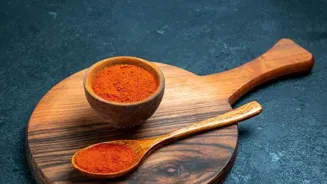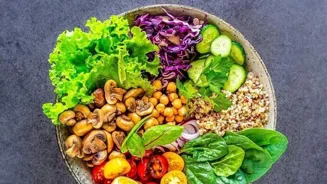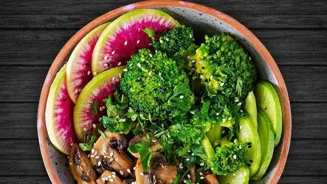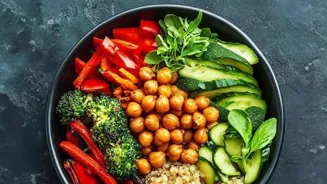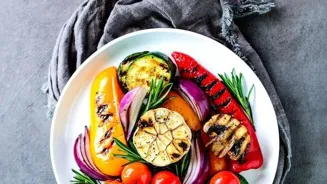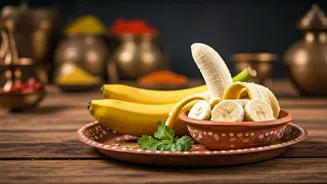Unlock the secrets to a balanced Indian diet: Dive into regional flavors & nutrition tips for a healthier you!
Namaste, readers! In a country as diverse as India, our food habits are just as varied. From
the mountains of Kashmir to the beaches of Kerala, each region boasts its own unique cuisine and flavors. But with so much choice, it can be tricky to ensure we're getting all the nutrients our bodies need.
A balanced Indian diet is key to not only good health, but also to maintaining energy levels and a strong immunity. Let's dive into how you can create a wholesome and satisfying Indian thali, keeping in mind the principles of balance and nourishment.
Traditional Indian thali: balanced diet canvas with varied food groups for health
Our Indian meals are traditionally structured around the concept of a "thali" – a platter offering a variety of dishes. This is a great starting point for building a balanced diet. Think of your thali as a canvas, and the food groups as the colors you use to paint a picture of health.
The core components of a balanced Indian meal should include carbohydrates, proteins, healthy fats, vitamins, and minerals.
While many of us lean heavily towards carbs, especially refined ones like white rice and maida, it's important to make smart choices to ensure we feel energetic and healthy throughout the day.
Choose whole grains for energy, plant proteins for health, and good fats for nutrition
When it comes to carbohydrates, opt for whole grains like brown rice, whole wheat roti, millets (ragi, jowar, bajra), and oats. These provide sustained energy and are rich in fiber, which is crucial for digestion and preventing that afternoon slump.
Proteins are the building blocks of our bodies, essential for muscle repair, growth, and overall health. Plant-based protein sources like lentils (dal), chickpeas (chana), kidney beans (rajma), moong beans, tofu, and paneer are staples in the Indian diet.
Including a serving of one or two of these in your daily meals ensures you meet your protein requirements. Don't forget to add a source of good fats to your diet. It’s very crucial for your body.
Include healthy fats like ghee, nuts, seeds, avocados. Eat colorful veggies/fruits for micronutrients
Healthy fats are often misunderstood, but they are vital for brain function, hormone production, and absorption of fat-soluble vitamins. Include sources like ghee (in moderation!), nuts, seeds, and avocados in your diet. Vitamins and minerals are readily available in colorful vegetables and fruits.
Make sure to include a variety of seasonal vegetables and fruits in your daily meals to get a wide range of micronutrients. Focus on leafy greens like spinach and methi, as well as vibrant colored vegetables like carrots, beetroot, and bell peppers. Remember, a colorful plate is a healthy plate!
Practice portion control for healthy eating & weight management
Now, let's talk about portion control. Even healthy foods can lead to weight gain if consumed in excess. Use smaller plates and be mindful of your portions. Try to fill half your plate with vegetables, one-quarter with whole grains, and one-quarter with protein.
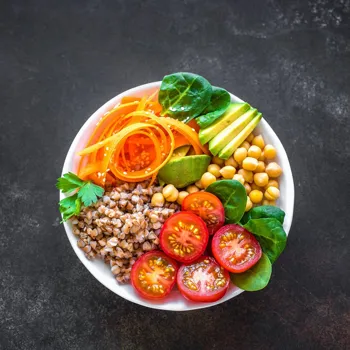
Also, listen to your body's hunger cues. Eat when you're truly hungry, and stop when you're satisfied, not stuffed. Mindful eating is a powerful tool for maintaining a healthy relationship with food.
Take your time to savor each bite, pay attention to the textures and flavors, and appreciate the nourishment you're providing your body.
Traditional Indian recipes offer balanced nutrition like dal-roti-sabzi and khichdi; try easy recipes at home
Many traditional Indian recipes are naturally balanced and nourishing. For example, a simple dal-roti-sabzi meal provides a good balance of carbohydrates, protein, and vitamins. Similarly, a bowl of khichdi (a comforting mix of rice, lentils, and vegetables) is a complete meal in itself.
Here are a couple of easy and healthy recipes you can try at home: Vegetable Pulao: Sauté vegetables like carrots, peas, beans, and cauliflower with spices like cumin seeds, turmeric, and garam masala. Add washed basmati rice and water, and cook until the rice is fluffy.
Garnish with fresh coriander leaves. Sprouted Moong Salad: Soak moong beans overnight and let them sprout for a day or two. Mix the sprouts with finely chopped onions, tomatoes, cucumber, and coriander leaves. Add a squeeze of lemon juice and a pinch of salt and pepper.
This salad is packed with protein and fiber.
Stay hydrated with water and hydrating drinks for a balanced diet
Hydration is another crucial aspect of a balanced diet that we often overlook. Drink plenty of water throughout the day to stay hydrated. Aim for at least 8-10 glasses of water daily. You can also include hydrating drinks like coconut water, buttermilk, and herbal teas in your diet.

These not only quench your thirst but also provide essential electrolytes and nutrients. Avoid sugary drinks and processed juices, as they are high in calories and offer little nutritional value.
Skipping breakfast hampers metabolism, include protein for satiety
One common mistake people make is skipping meals, especially breakfast. Breakfast is the most important meal of the day, as it kickstarts your metabolism and provides you with the energy you need to get through the day.
A healthy Indian breakfast could include poha, upma, idli, dosa, or a bowl of oats with nuts and fruits. Make sure to include a source of protein in your breakfast to keep you feeling full and satisfied until lunchtime.
Avoid processed foods, opt for whole, unprocessed foods for health
Another important tip is to avoid processed foods as much as possible. Processed foods are often high in sugar, salt, and unhealthy fats, and they lack essential nutrients. Instead, focus on eating whole, unprocessed foods like fruits, vegetables, whole grains, and legumes.
Cooking your own meals allows you to control the ingredients and portion sizes, making it easier to maintain a healthy diet. Experiment with different spices and herbs to add flavor to your dishes without adding extra salt or sugar.
Mindful eating habits promote satisfaction and prevent overconsumption
It's also important to be mindful of your eating habits. Avoid eating in front of the television or while working, as this can lead to mindless eating and overconsumption. Instead, sit down at the table and focus on your meal. Chew your food thoroughly and savor each bite.
This will help you feel full and satisfied with less food. Additionally, try to eat your meals at regular intervals to maintain stable blood sugar levels and prevent cravings.
Creating balanced Indian diet: gradual changes for health and well-being
Finally, remember that creating a balanced Indian diet is a gradual process. Don't try to make too many changes at once, as this can be overwhelming and unsustainable.
Start by making small, manageable changes to your diet, such as swapping white rice for brown rice or adding a serving of vegetables to each meal. Over time, these small changes will add up to a significant improvement in your overall health and well-being.
It's not about perfection, but about progress and making conscious choices that nourish your body and mind.
Explore diverse Indian recipes for a balanced diet
Let's delve a bit deeper into some more specific recipe ideas that align with our balanced Indian diet philosophy. Remember, variety is key to ensure you're getting a wide range of nutrients.
Don't be afraid to experiment with different spices and cooking techniques to create delicious and healthy meals that you enjoy. The more you enjoy your food, the more likely you are to stick to your healthy eating habits.
Nutritious Vegetable Dalia for a wholesome breakfast
Start your day with a hearty bowl of Vegetable Dalia. Dalia is broken wheat, a highly nutritious grain that is rich in fiber and protein. Cook the dalia with a medley of vegetables like carrots, peas, beans, and potatoes. Season with turmeric, cumin, and a pinch of asafoetida for flavor.
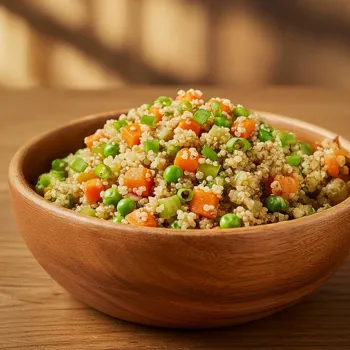
This is a wholesome and filling breakfast that will keep you energized throughout the morning. You can also try adding a dollop of curd for extra protein and probiotics.
Nutritious Palak Paneer & Roti lunch with cucumber raita
For lunch, consider a comforting plate of Palak Paneer with Roti. Palak Paneer is a classic Indian dish made with spinach and paneer cheese. It's a good source of iron, protein, and calcium. Serve it with whole wheat roti for a balanced meal.
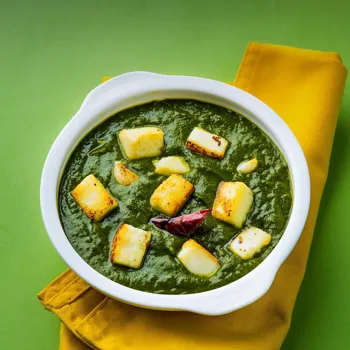
Make sure to use low-fat paneer and go easy on the oil to keep the dish healthy. You can also add a side of cucumber raita for a cooling and refreshing complement.
Khichdi is a versatile, nutritious dinner option with many variations
As previously mentioned, Khichdi is an excellent option for a light and nutritious dinner. There are many variations of khichdi, so you can easily customize it to your liking. Try making moong dal khichdi with lots of vegetables like cauliflower, carrots, and spinach.

Season it with turmeric, ginger, and garlic for flavor. Khichdi is easy to digest and provides a good balance of carbohydrates, protein, and vitamins. And lastly, a glass of warm milk before bed can help you relax and sleep better.
Remember to choose low-fat milk and add a pinch of turmeric for its anti-inflammatory benefits.
Colorful salad complements a healthy diet
And a side of colorful salad would work greatly for your healthy diet.
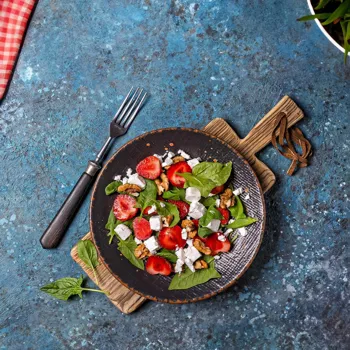
Healthy snacking tips for stable blood sugar levels
Beyond the main meals, let's consider some healthy snacking options to keep you going between meals without derailing your diet. Snacking is an important part of maintaining stable blood sugar levels and preventing overeating at mealtimes. However, it's important to choose your snacks wisely.
Avoid processed snacks like chips, cookies, and sugary drinks. Instead, opt for healthier options like fruits, nuts, seeds, and yogurt.
Nuts, fruits, yogurt - healthy snack options
A handful of almonds or walnuts makes an excellent snack, providing healthy fats, protein, and fiber. You can also try roasted chana (chickpeas), which is a good source of protein and keeps you feeling full.
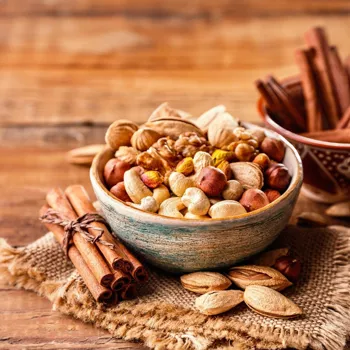
Fruits like apples, bananas, and oranges are packed with vitamins and minerals and provide a natural source of sweetness. A small bowl of plain yogurt with berries is another healthy and satisfying snack option. You can also add a sprinkle of granola for extra crunch.
Choose healthier cooking methods: steaming, baking, grilling over frying
When it comes to cooking methods, opt for healthier options like steaming, baking, and grilling over frying. Frying adds unnecessary calories and unhealthy fats to your food. Steaming preserves the nutrients in vegetables and keeps them tender.
Baking is a good option for cooking dishes like tandoori chicken and vegetable kebabs. Grilling is a great way to add flavor to your food without adding extra fat. Remember to use minimal oil when cooking and choose healthy oils like olive oil or sunflower.
Try to include atleast 1 portion of fruits per week.
Read food labels for informed choices on nutrition
Another helpful tip is to read food labels carefully. Pay attention to the serving sizes, calorie content, and nutritional information. Be wary of foods that are high in sugar, salt, and unhealthy fats. Look for foods that are rich in fiber, protein, and vitamins.
Understanding food labels can help you make informed choices about the foods you eat. Be aware of the food that you are eating and its contents.
Balanced diet, exercise, sleep, and stress management for overall health
And lastly, remember that a balanced diet is just one piece of the puzzle when it comes to overall health and well-being. Regular exercise, adequate sleep, and stress management are also essential for maintaining a healthy lifestyle. Aim for at least 30 minutes of exercise most days of the week.

Get 7-8 hours of sleep each night. And find healthy ways to manage stress, such as yoga, meditation, or spending time in nature. Remember to eat well and stay happy with a balanced diet.
